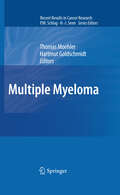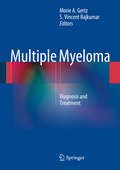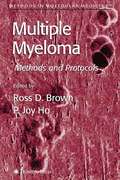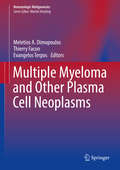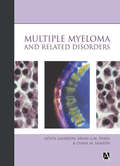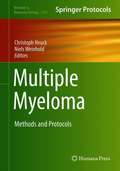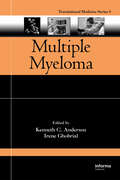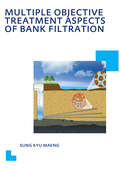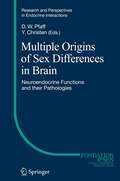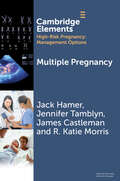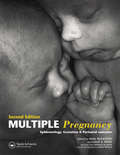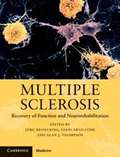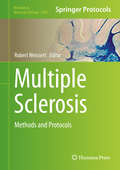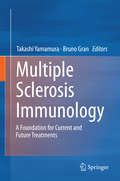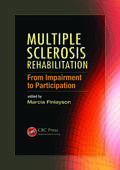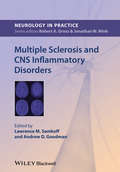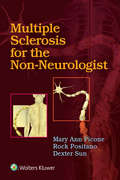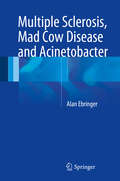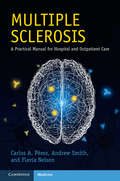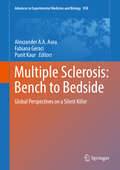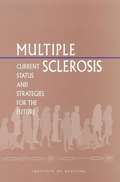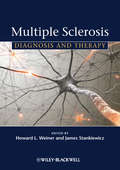- Table View
- List View
Multiple Myeloma
by Hartmut Goldschmidt Thomas MoehlerMultiple myeloma is currently still an incurable disease, but during the past decade knowledge of its molecular pathogenesis has increased rapidly. This has led to remarkable progress in both diagnosis and therapy, including in particular the approval of novel and first-in-class drugs such as thalidomide, bortezomib, and lenalidomide. This book, written by internationally acknowledged experts, covers a wide range of topics relating to multiple myeloma, including history, epidemiology, pathophysiology, clinical features, staging, and prognostic systems. The principal focus, however, is on therapy, with detailed information on the various promising treatment options which give hope that this cancer will be transformed into a chronic disease or even become curable. Individualized therapy and the variety of supportive treatment options, as described in this volume, will help in achieving this goal, as well as in reducing adverse events and improving quality of life.
Multiple Myeloma
by Morie A. Gertz S. Vincent RajkumarThis is a comprehensive, state-of-the-art guide to the diagnosis, treatment, and biology of multiple myeloma and related plasma disorders Edited and written by a multidisciplinary group of recognized authorities from the Mayo Clinic, it presents clear guidelines on diagnosis and therapy and covers all aspects of multiple myeloma, from molecular classification and diagnosis, to risk stratification and therapy Closely related plasma cell disorders such as solitary plasmacytoma, Waldenstrom macroglobulinemia, and light chain amyloidosis are discussed in detail as well. The book addresses often overlooked topics, including the role of radiation therapy, vertebral augmentation, and supportive care. Our understanding of this group of disorders is developing at an unprecedented rate, and Multiple Myeloma meets the need among oncologists and hematologists for a clear, timely, and authoritative resource on their biology, diagnosis, and treatment.
Multiple Myeloma
by P. Joy Ho Ross D. BrownA comprehensive collection of classic and innovative methodologies used in many laboratories for the investigation of multiple myeloma. These readily reproducible techniques range from the standard Plasma Cell Labeling Index methodology to a final chapter on making sense of microarrays, and include the full spectrum of cytogenetic and molecular diagnostic methods. The protocols follow the successful Methods in Molecular MedicineTM series format, each offering step-by-step laboratory instructions, an introduction outlining the principle behind the technique, lists of the necessary equipment and reagents, and tips on troubleshooting and avoiding known pitfalls. These proven techniques are ideal for studying the pathogenesis of multiple myeloma and identifying new therapeutic targets.
Multiple Myeloma and Other Plasma Cell Neoplasms (Hematologic Malignancies #0)
by Meletios A. Dimopoulos Thierry Facon Evangelos TerposThis book is a comprehensive source of up-to-date information on plasma cell neoplasms. Key features include the provision of new criteria for the diagnosis of symptomatic multiple myeloma requiring treatment and the description of novel therapies for myeloma and other plasma cell neoplasms that have only very recently been licensed by the U.S. Food and Drug Administration. Examples include lenalidomide as first-line therapy, panobinostat in combination with bortezomib plus dexamethasone for relapsed/refractory myeloma, ibrutinib for Waldenström’s macroglobulinemia, and new therapeutic regimens for systemic amyloidosis and POEMS syndrome. Information is also provided on drug combinations that have shown encouraging results and are very near to approval. Other important aspects covered in the book are the role of different imaging modalities in workup and the significance of newly acquired data relating to prognosis and minimal residual disease. Readers will find Multiple Myeloma and Other Plasma Cell Neoplasms to be a rich source of knowledge that will be invaluable in improving patient management.
Multiple Myeloma and Related Disorders
by Brian Gösta Gahrton Diana M. SamsonDuring the past decade there has been an enormous increase in knowledge of multiple myeloma and related disorders, reflected in the publication of more than 5000 articles on the subject in scientific journals. Much of this has come about as new technologies have made it possible to refine studies on chromosomes and genes and to gain information abo
Multiple Myeloma: Methods And Protocols (Methods in Molecular Biology #1792)
by Christoph Heuck Niels WeinholdThis volume provides a thorough guide of the study of multiple myeloma (MM)—from sample acquisition to the performance of molecular tests, and also discusses difficulties that arise during quality control and interpretation of results. The chapters in this book cover topics, such as next-generation-flow-based methods for detection of minimal residual disease and circulating tumor cells; Cytometry by Time-of-Flights (CyTOF); a droplet digital PCR approach for finding contamination in patients’ samples; genome-wide investigation of the methylation and hydroxymethylation status of cytosines; and a microfluidic approach for creating nanoparticles. Written in the highly successful Methods in Molecular Biology series format, chapters include introductions to their respective topics, lists of the necessary materials and reagents, step-by-step, readily reproducible laboratory protocols, and tips on troubleshooting and avoiding known pitfalls. Cutting-edge and comprehensive, Multiple Myeloma: Methods and Protocols is a valuable resource for molecular scientists and laboratory supervisors working with MM samples, and any investigator conducting studies in this field.
Multiple Myeloma: Translational and Emerging Therapies (Translational Medicine)
by Kenneth C. Anderson Irene M. GhobrialMultiple myeloma is the second most prevalent hematological malignancy, with over 55,000 new cases diagnosed each year. This exciting new text, edited by lauded authorities on the topic, stands as the only available reference to assemble, review, and synthesizes the latest studies on translational therapies and clearly explains the impact of molecular pathogenesis, biology, and prognostic factors on the diagnosis, prognosis, and individualization of treatment and the development of novel therapeutic options for patients with myeloma.
Multiple Objective Treatment Aspects of Bank Filtration: Unesco-ihe Phd Thesis
by Sung Kyu MaengBank filtration (BF) is a natural water treatment process which induces surface water to flow in response to a hydraulic gradient through soil/sediment and into a vertical or horizontal well. It is a relatively cost-effective, robust and sustainable technology. From a historical perspective, BF is first mentioned in the bible, and the process has been recognized as a proven method for drinking water treatment in Europe for more than 100 years. However, the mechanisms of removal of different contaminants during BF are not fully understood. This study showed that BF is an effective multiple objective barrier for removal of different contaminants present in surface water sources including bulk organic matter and organic micropollutants (OMPs) like pharmaceutically active compounds and endocrine disrupting compounds. It was found that biodegradation and adsorption play primary and secondary roles, respectively, in the removal of OMPs during soil passage. Furthermore, using field data from BF sites and chemical properties of OMPs, models were developed to estimate the removal of OMPs during soil passage. It can be concluded that the removal efficiencies of BF for these contaminants can be maximised by proper design and operation of recovery wells taking into consideration source water quality characteristics and local hydrogeological conditions.
Multiple Origins of Sex Differences in Brain
by Yves Christen Donald W PfaffIn theoretical terms, sex differences in brains and behaviors of laboratory animals offer the possibility of fascinating scientific studies on a range of molecular phenomena such as genomic imprinting, DNA methylation, chromatin protein modification, non-coding DNA, potentially resulting in important neuroanatomical and neurochemical sex differences in the brain. Such sex differences could arise consequent to exposures to testosterone early in development, or to other effects deriving from the Y chromosome. However, this general subject has been treated with much hyperbole. Historically, sex differences were assumed to be present where they did not really exist, e.g. with respect to mathematics, executive leadership, etc. etc. Under what circumstances do we really care about sex differences in brain and behavior? These circumstances concern human maladies whose diagnoses are much different between boys and girls, or between women and men. Prominent examples discussed in this volume include autism, attention deficit hyperactivity disorders and congenital adrenal hyperplasia. In fact, infant boys are more susceptible than infant girls to a variety of disorders that arise early in development. This volume then ends with a consideration of effects of estrogenic hormones on the injured brain, and their roles as protective agents.
Multiple Perspectives on Artificial Intelligence in Healthcare: Opportunities and Challenges (Lecture Notes in Bioengineering)
by Mowafa Househ Elizabeth Borycki Andre KushnirukThis book offers a comprehensive yet concise overview of the challenges and opportunities presented by the use of artificial intelligence in healthcare. It does so by approaching the topic from multiple perspectives, e.g. the nursing, consumer, medical practitioner, healthcare manager, and data analyst perspective. It covers human factors research, discusses patient safety issues, and addresses ethical challenges, as well as important policy issues. By reporting on cutting-edge research and hands-on experience, the book offers an insightful reference guide for health information technology professionals, healthcare managers, healthcare practitioners, and patients alike, aiding them in their decision-making processes. It will also benefit students and researchers whose work involves artificial intelligence-related research issues in healthcare.
Multiple Pregnancy (Elements in High Risk Pregnancy: Management Options)
by Jack Hamer Jennifer Tamblyn James Castleman R. Katie MorrisMultiple pregnancy affects 0.9-3.1% of births worldwide. Prevalence rates vary significantly due to differences in dizygotic twinning rates and use of assisted reproduction (AR). Both maternal and fetal/neonatal complications are more common in multiple compared to singleton pregnancies and there are specific problems for the fetuses related to monochorionicity. Multiple pregnancies require specialized and individualized care. Complicated multiple pregnancies should be managed in a tertiary care centre where there is additional expertise, such as the laser ablation needed to treat monochorionic monozygotic pregnancies with conjoined circulations. Cornerstones of management in pregnancy are the need for accurate fetal measurement to optimise dating of gestational age, and documentation of chorionicity. High level ultrasound expertise is needed. The mothers need frequent assessment to detect hypertension and anemia, and early identification and management of preterm labor.
Multiple Pregnancy: Epidemiology, Gestation, and Perinatal Outcome
by Isaac BlicksteinEstablishing the study of multiple pregnancy and the perinatal care of children from multiple births as a recognized specialty within maternal-fetal medicine, the first edition of Multiple Pregnancy was a landmark publication. Fully revised, this new Second Edition has been expanded to include more on epidemiology, biologic mechanisms, the impact o
Multiple Sclerosis
by Jürg Kesselring Giancarlo Comi Alan J. ThompsonIn multiple sclerosis (MS), conventional magnetic resonance imaging (cMRI) has proved to be a valuable tool to increase diagnostic confidence and for monitoring the efficacy of experimental treatment. However, cMRI has limited specificity and accuracy of cMRI to the most disabling aspects of the MS pathology, known to occur in and outside macroscopic lesions. Modern quantitative MR techniques have the potential to overcome the limitations of cMRI, and their application is changing dramatically our understanding of how MS causes irreversible disability. In detail, there is an increasing body of MR evidence that MS is not only a white matter disease and does not only cause focal lesions, as well as that neurodegeneration is an important aspect of the disease (since the earliest clinical phases), which is only partially related to inflammatory changes. There is also increasing perception that modern MR methodologies should be more extensively employed in clinical trials to derive innovative information. Written by world-renowned scientists, the volume provides a state-of-the-art on the most recent MRI techniques related to MS, and it will bi and indispensable tool for all those working in this field.
Multiple Sclerosis
by Robert WeissertThis detailed volume covers molecular biology, cellular biology, biomarkers, imaging, and neuropathological methods and techniques to explore multiple sclerosis (MS), with a special emphasis on disease models. With so much effort needed to elucidate basic disease mechanisms, to clone disease relevant genes, to define novel biomarkers, and to discover novel and improved therapeutic and curative treatments, this book serves to aid researchers in accomplishing these enormous goals. Written for the highly successful Methods in Molecular Biology series, chapters include introductions to their respective topics, lists of the necessary materials and reagents, step-by-step, readily reproducible laboratory protocols, and tips on troubleshooting and avoiding known pitfalls. Practical and easy to use, Multiple Sclerosis: Methods and Protocols will empower the reader to perform novel research regarding pathophysiology and treatment for MS.
Multiple Sclerosis Immunology
by Takashi Yamamura Bruno GranThe availability of powerful genome-wide association study technology, during the last five years, has shown that most of the "new" MS susceptibility loci are immune-response genes. It is clear that there is much novelty in the field of MS immunology, which has served as an impetus to invest in new therapies. Notably, most if not all of these are immunotherapies. Even the equally exciting field of cell-based therapies and neuro-regeneration may well rely on cells or growth factors that are no less immunomodulators than restorative of myelin and neural cell function. Multiple Sclerosis Immunology looks at MS immunology as the basis for the present and--even more--the future of treatments for this complex autoimmune condition. Both editors are immunologists, as well as clinical neurologists, and appreciate the importance of a sustained dialogue between basic and clinical scientists to ensure that "translation" is real and not just virtual.
Multiple Sclerosis Rehabilitation: From Impairment to Participation (Rehabilitation Science in Practice Series)
by Marcia Finlayson"MS is always in the back of your mind. If there is something you want to do, you always wonder if the MS will allow you do to it."-Darlene, living with MS for 22 yearsLiving with multiple sclerosis (MS) is challenging and multidimensional. MS pervades all aspects of life: one's body becomes unpredictable and unreliable, one's identity and sense of
Multiple Sclerosis Therapeutics
by Eli Minkoff Eli BakerSince the publication of the previous edition of this volume, there has been substantial progress in a number of areas of multiple sclerosis (MS) research. Although immunosuppressive treatments continue to be developed and refined, more targeted immunomodulatory therapies are surfacing as we learn more about how the immune system works in health an
Multiple Sclerosis Therapeutics
by Jeffrey A. Cohen Richard A. RudickThis book comprehensively reviews the current state of clinical trial methods in multiple sclerosis treatment, providing investigators, sponsors and specialists with current knowledge of outcome measures and study designs for disease and symptom management. The status of the rapidly evolving field of disease-modifying drugs is presented, with emphasis on the most promising therapies currently being tested. Experts discuss disease and symptom management for MS subtypes, including neuromyelitis optica and pediatric MS. In addition, key scientific advances in MS pathology, genetics, immunology and epidemiology are presented. The fourth edition has been extensively revised, featuring more than 50% new material. All chapters have been substantially updated to provide current information on rapidly evolving topics and this volume contains 15 new chapters, reflecting the growth of the field in recent years. This book is an essential reference for practitioners caring for MS patients, investigators planning or conducting clinical trials, and clinical trial sponsors.
Multiple Sclerosis and CNS Inflammatory Disorders
by Lawrence M. Samkoff Andrew D. GoodmanMultiple Sclerosis and CNS Inflammatory Disorders is a practical guide to effective care of patients with multiple sclerosis and other neuroimmunologic and CNS inflammatory disorders.It provides the scientific basis of multiple sclerosis including etiology, epidemiology, and pathogenesis. It covers the diagnostic process, the course of the disease and prognosis, and the use of MRI in diagnosis and disease monitoring. Disease-modifying treatment algorithms for relapsing-remitting multiple sclerosis, switching therapy, and progressive multiple sclerosis treatment algorithms are all discussed in detail. It also addresses multiple sclerosis in childhood and pregnancy and includes assessment of alternative therapies.This new addition to the Neurology in Practice series contains practical guidance and learning features:* Algorithms and guidelines* "Tips and Tricks" boxes on improving outcomes* "Caution" warning boxes to avoiding problems* "Science Revisited"--quick reminders of the basic science principles necessary for understandingMultiple Sclerosis and CNS Inflammatory Disorders is an ideal reference for neurologists in practice and training.
Multiple Sclerosis for the Non-Neurologist
by Mary Ann PiconeRecent rapid changes in the field of multiple sclerosis management have made the task of staying well-informed a challenge for neurologists, and even more so for other healthcare practitioners who are involved in symptom evaluation and treatment. Multiple Sclerosis for the Non-Neurologist is an up-to-date resource for physicians, residents, fellows, and others who care for patients with MS. It contains authoritative information on all aspects of this complex disease, including monitoring requirements for patients with MS, potential risks and adverse events of disease modifying or symptomatic therapies, and possible drug interactions and contraindications of medications.
Multiple Sclerosis, Mad Cow Disease and Acinetobacter
by Alan EbringerThe aim of this book is to publicise and bring to a wider audience the concept that the cause of two neurological diseases, namely multiple sclerosis (MS) and "mad cow disease" also known as "bovine spongiform encephalopathy" are related through exposure to a common microbe Acinetobacter which is found in human sinuses, on skin and in the soil. An infection is the cause of a neurological disease in man and in animals. Elevated levels of antibodies to Acinetobacter have been found in multiple sclerosis patients as well as in ruminants who have been described as suffering from "mad cow disease" following exposure to contaminated feed supplements. The overall objective and scope of this book is to inform the audience, the reader, that multiple sclerosis may be linked to a microbe Acinetobacter which carries molecular structures resembling myelin, the outer sheath covering of neurons.
Multiple Sclerosis: A Practical Manual for Hospital and Outpatient Care (Cambridge Manuals in Neurology)
by Andrew Smith Carlos A. Perez Flavia NelsonAffecting an estimated 2.5 million people worldwide, multiple sclerosis (MS) is the most common neurological cause of debilitation in young adults. Incurable, and with the precise causes still unknown, both diagnosis and management of the condition is complicated. This book summarizes the latest understanding of the causes of the disease, using accessible, bullet-point text to describe key clinical features and diagnostic criteria. Disease-modifying therapies and management of symptoms, including fatigue, tremor and cognitive changes, are covered in detail. With a chapter focusing solely on presentations in the emergency room, the importance of recognizing these neurological emergencies is emphasised, along with indications for admission in MS patients. The impact of MS on women's reproductive health and the increasing recognition of MS in pediatric patients is also explored. An up-to-date and practical approach to the accurate diagnosis and management of MS, this is an invaluable resource for both hospital and outpatient settings.
Multiple Sclerosis: Bench to Bedside
by Alexzander A. A. Asea Punit Kaur Fabiana GeraciMultiple Sclerosis (MS) is one of the main causes of disability in young adult population. The estimated burden of the disease worldwide is about three million people. The pathogenic mechanism of MS involves both auto immune and degenerative processes. These two mechanisms are thought to determine a combination of events leading to several clinical pattern of disease onset and course. Multiple Sclerosis: Bench to Bedside provides the most up-to-date and concise reviews on the critical issues of multiple sclerosis from around the world. This book is written by leaders and experts in the field of multiple sclerosis research and is divided into easy to read sections. Section I focuses on basic science aspects of Multiple Sclerosis, including potential biomarkers, molecular biology, heat shock proteins, oxidative stress, genetic and epigenetics. Section II focuses on clinical and epidemiological aspects of Multiple Sclerosis, including remyelination therapy, neuroplasticity-based technologies and interventions. This is an important reference book and a must-read for Postgraduate Medical Scholars, Basic Science Researchers and Neurologists in Clinical Practice.
Multiple Sclerosis: Current Status And Strategies For The Future
by Institute of MedicineMultiple sclerosis is a chronic and often disabling disease of the nervous system, affecting about 1 million people worldwide. Even though it has been known for over a hundred years, no cause or cure has yet been discovered-but now there is hope. New therapies have been shown to slow the disease progress in some patients, and the pace of discoveries about the cellular machinery of the brain and spinal cord has accelerated.This book presents a comprehensive overview of multiple sclerosis today, as researchers seek to understand its processes, develop therapies that will slow or halt the disease and perhaps repair damage, offer relief for specific symptoms, and improve the abilities of MS patients to function in their daily lives.The panel reviews existing knowledge and identifies key research questions, focusing on: Research strategies that have the greatest potential to understand the bio- logical mechanisms of recovery and to translate findings into specific strategies for therapy. How people adapt to MS and the research needed to improve the lives of people with MS. Management of disease symptoms (cognitive impairment, depression, spasticity, vision problems, and others). The committee also discusses ways to build and financially support the MS research enterprise, including a look at challenges inherent in designing clinical trials. This book will be important to MS researchers, research funders, health care advocates for MS research and treatment, and interested patients and their families.
Multiple Sclerosis: Diagnosis and Therapy (Perspectives Cshl Ser.)
by Howard L. Weiner James M. StankiewiczMultiple Sclerosis: a complex disease requiring sophisticated management Multiple Sclerosis poses labyrinthine challenges. There is no blood test to rely on for diagnosis; clinical acumen is essential. Yet an effective diagnosis only takes you part of the way: treatment offers further enigmas. The MS treatment landscape is complicated, and will become even more so with time. Multiple Sclerosis: Diagnosis and Therapy is the map you need to navigate this maze. Written and edited by leaders in the field, it guides you towards effective and positive choices for your patients. The diagnosis section provides state-of-the-art thinking about pathogenesis. With clear coverage of biomarkers, genetics, and imaging, it presents a coherent framework for making the correct diagnosis. The management section comprehensively covers current and future treatments to steer you through the many options for • Symptom management • Cognitive dysfunction • Depression and other mental health issues ‘Top Tips’ throughout provide the practical guidance you need for the best management of your patients. Multiple Sclerosis: Diagnosis and Therapy should be on the bookshelf of anyone who treats patients with multiple sclerosis.
